波点女王—草间弥生
- 格式:pptx
- 大小:25.12 MB
- 文档页数:29
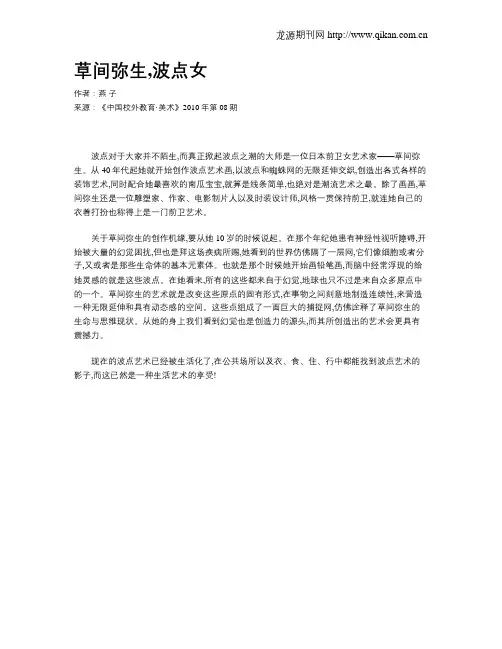
龙源期刊网
草间弥生,波点女
作者:燕子
来源:《中国校外教育·美术》2010年第08期
波点对于大家并不陌生,而真正掀起波点之潮的大师是一位日本前卫女艺术家——草间弥生。
从40年代起她就开始创作波点艺术画,以波点和蜘蛛网的无限延伸交织,创造出各式各样的装饰艺术,同时配合她最喜欢的南瓜宝宝,就算是线条简单,也绝对是潮流艺术之最。
除了画画,草间弥生还是一位雕塑家、作家、电影制片人以及时装设计师,风格一贯保持前卫,就连她自己的衣着打扮也称得上是一门前卫艺术。
关于草间弥生的创作机缘,要从她10岁的时候说起。
在那个年纪她患有神经性视听障碍,开始被大量的幻觉困扰,但也是拜这场疾病所赐,她看到的世界仿佛隔了一层网,它们像细胞或者分子,又或者是那些生命体的基本元素体。
也就是那个时候她开始画铅笔画,而脑中经常浮现的给她灵感的就是这些波点。
在她看来,所有的这些都来自于幻觉,地球也只不过是来自众多原点中的一个。
草间弥生的艺术就是改变这些原点的固有形式,在事物之间刻意地制造连续性,来营造一种无限延伸和具有动态感的空间。
这些点组成了一面巨大的捕捉网,仿佛诠释了草间弥生的
生命与思维现状。
从她的身上我们看到幻觉也是创造力的源头,而其所创造出的艺术会更具有
震撼力。
现在的波点艺术已经被生活化了,在公共场所以及衣、食、住、行中都能找到波点艺术的
影子,而这已然是一种生活艺术的享受!。
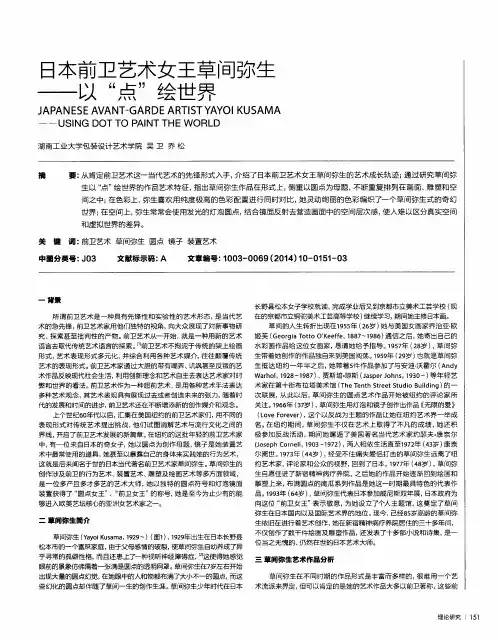
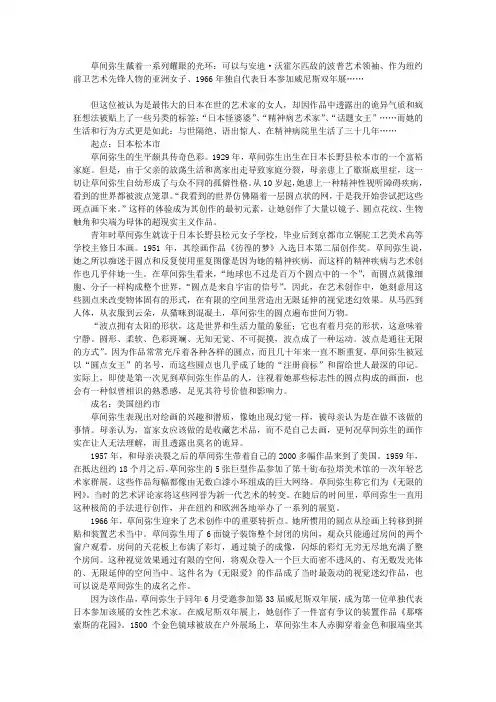
草间弥生戴着一系列耀眼的光环:可以与安迪·沃霍尔匹敌的波普艺术领袖、作为纽约前卫艺术先锋人物的亚洲女子、1966年独自代表日本参加威尼斯双年展……但这位被认为是最伟大的日本在世的艺术家的女人,却因作品中透露出的诡异气质和疯狂想法被贴上了一些另类的标签:“日本怪婆婆”、“精神病艺术家”、“话题女王”……而她的生活和行为方式更是如此:与世隔绝、语出惊人、在精神病院里生活了三十几年……起点:日本松本市草间弥生的生平颇具传奇色彩。
1929年,草间弥生出生在日本长野县松本市的一个富裕家庭。
但是,由于父亲的放荡生活和离家出走导致家庭分裂,母亲患上了歇斯底里症,这一切让草间弥生自幼形成了与众不同的孤僻性格。
从10岁起,她患上一种精神性视听障碍疾病,看到的世界都被波点笼罩。
“我看到的世界仿佛隔着一层圆点状的网,于是我开始尝试把这些斑点画下来。
”这样的体验成为其创作的最初元素,让她创作了大量以镜子、圆点花纹、生物触角和尖端为母体的超现实主义作品。
青年时草间弥生就读于日本长野县松元女子学校,毕业后到京都市立铜驼工艺美术高等学校主修日本画。
1951年,其绘画作品《彷徨的梦》入选日本第二届创作奖。
草间弥生说,她之所以痴迷于圆点和反复使用重复图像是因为她的精神疾病,而这样的精神疾病与艺术创作也几乎伴她一生。
在草间弥生看来,“地球也不过是百万个圆点中的一个”,而圆点就像细胞、分子一样构成整个世界,“圆点是来自宇宙的信号”。
因此,在艺术创作中,她刻意用这些圆点来改变物体固有的形式,在有限的空间里营造出无限延伸的视觉迷幻效果。
从马匹到人体,从衣服到云朵,从猫咪到混凝土,草间弥生的圆点遍布世间万物。
“波点拥有太阳的形状,这是世界和生活力量的象征;它也有着月亮的形状,这意味着宁静。
圆形、柔软、色彩斑斓、无知无觉、不可捉摸,波点成了一种运动。
波点是通往无限的方式”。
因为作品常常充斥着各种各样的圆点,而且几十年来一直不断重复,草间弥生被冠以“圆点女王”的名号,而这些圆点也几乎成了她的“注册商标”和留给世人最深的印记。
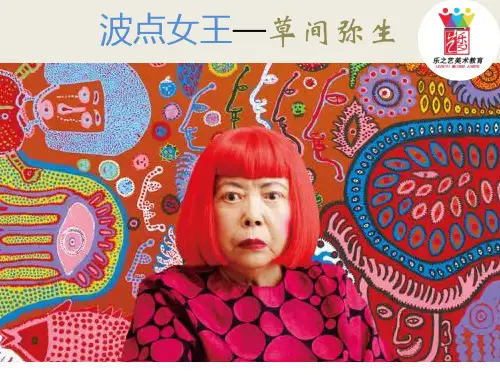

基于符号视角学视域看草间弥生作品的艺术性作者:***来源:《收藏与投资》2023年第12期摘要:本文通过符号学理论对草间弥生作品的圆点符号进行分析,探索她的人生经历来发掘圆点符号的来源。
她童年的经历对于她的艺术创作产生了很大的影响,这些都集中反映在她的作品之中,她通过艺术来表达自己对世界的热爱。
她因为圆点符号而闻名于世界,抽象的符号和醒目的颜色也让她成为时尚的宠儿。
因此,本文将从她的作品出发来分析作品背后的内在寓意。
关键词:符号学;圆点符号;草间弥生草间弥生作为当代艺术家,因其作品充满圆点符号而闻名于世,也被称为“波点女王”,圆点符号贯穿于她的作品中,从她画的第一张画开始就伴随至今。
她通过圆点符号的创作来表达自己对于这个世界的看法。
在她的世界里,圆点符号不仅是一个图形,还是来自宇宙和自然的信号。
因此,本文笔者将从符号学理论的视角对草间弥生的作品进行探析,去感受草间弥生的独特世界。
现代语言学家之父索绪尔曾经提出,语言学为符号学提供了基本模式,并提出符号的两种特性—“能指”和“所指”。
其中,“能指”指的是外在的表达形式以及客观的事物,“所指”指的是概念的、主观的内部世界,是文化信息的传播中介。
索绪尔曾多次强调符号的任意性,同一所指当人们在面对同一事物时会有不同的心理。
比如草间弥生的著名作品《波点南瓜》,可以作为一种非常重要的精神食粮,可以作为一种优美的艺术品,还可以作为圆点符号的一种象征。
与索绪尔二分法不同的是皮尔斯符号学的三分法,他用三元观点阐释了符号的传播过程。
皮尔斯将第一类命名为单一的符号、质的符号和法则的符号;第二类命名为图像、索引和象征;第三类命名为表位、命题符号和论证。
他强调“解释”即符号的含义,他在《皮尔斯:论符号》一书中提道:“符号的解释项就是符号所传达的所有事物,也即必须通过间接经验才能获得的与其对象相熟悉的那些东西。
”以草间弥生为代表的新型符号学研究者对符号进行了重新定义,草间弥生在《圆点女王,草间弥生》自传中提出:必须丧失自我的存在。
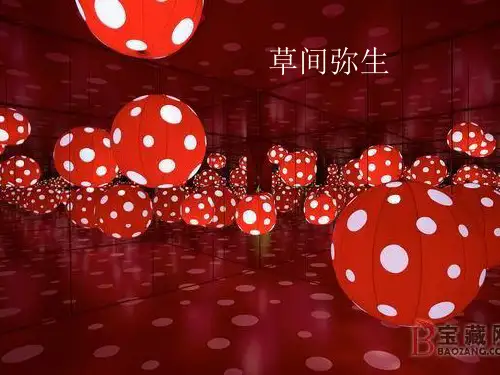
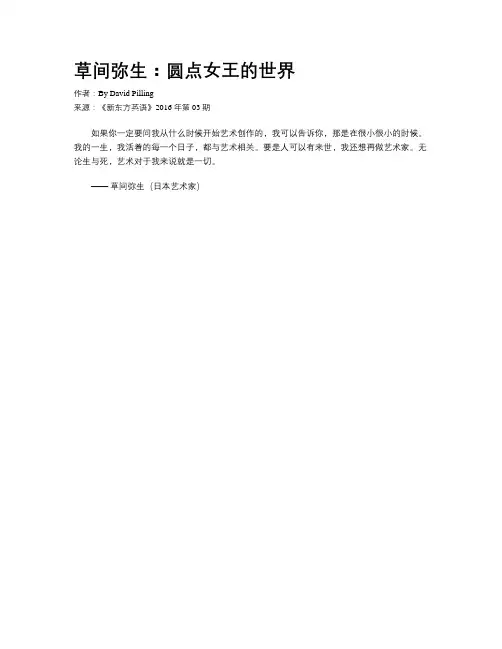
草间弥生:圆点女王的世界作者:By David Pilling来源:《新东方英语》2016年第03期如果你一定要问我从什么时候开始艺术创作的,我可以告诉你,那是在很小很小的时候。
我的一生,我活着的每一个日子,都与艺术相关。
要是人可以有来世,我还想再做艺术家。
无论生与死,艺术对于我来说就是一切。
——草间弥生(日本艺术家)Yayoi Kusama is 87 years old. But when she is wheeled in, on her blue polka-dotted wheelchair, she looks more like a baby, the sort you might see played by an adult in a British pantomime1). Her face is large for a Japanese woman and at odds2) with her smallish frame. Apart from her intense, saucer-shaped eyes and the arc of deep red lipstick across her mouth, there is something masculine about her features. She wears a lurid red wig and a dress covered in polka dots. Coiled around her neck is a long red scarf decorated with black squiggles. When she is out of the spotlight, without her splashy red wig and garish outfits, she looks like a nice, grey-haired old lady. It is as if the patterns she has obsessively replicated since childhood have seeped off the canvas and into the three-dimensional world of flesh and blood.Kusama’s story begins in the conservative surroundings of rural Japan in 1929, where she was born in Matsumoto, Nagano prefecture3), into a family of seedling merchants. One early photo, taken at the age of about 10, shows a serious, rather beautiful girl with short hair,holding an enormous bunch of chrysanthemums4). So upstanding was her mother’s family, that her father, a philanderer5) who spent much of his time in the company of geisha6), adopted the Kusama name as his own. At around the time the photograph was taken, Kusama was already producing pencil sketches featuring dots and a net-like motif. Even a portrait of her mother, whom she hated for her strictness and prudish7) values, is covered in dots as though she were suffering from chicken pox. “My parents were a real pain,” she says. “I couldn’t stand it. They were very conservative. My family had been running the business for 100 years. My parents had old customs and morals.”From early childhood Kusama experienced “visual and au ral hallucinations8).” In her autobiography,she writes of her experience sitting among a bed of violets. “One day, I suddenly looked up to find that each and every violet had its own individual, human-like facial expression,and to my astonishment they we re all talking to me.” On other occasions,“suddenly things would be flashing and glittering all around me. So many different images leaped into my eyes that I was left dazzled and dumbfounded.” Whenever these hallucinations occurred, she would rush home and draw what she had seen.In 1948, after the war had ended, she began a formal course in Kyoto where she was instructed in Nihonga9), a style of Japanese painting. She hated the rigidities of the master-disciple system where students were supposed to imbibe10) tradition through the sensei11). “When I think of my life in Kyoto,” she says,“I feel like vomiting.”She began to absorb the influences of cubism and surrealism, gleaned from magazines. In these styles she was almost entirely self-taught. Her artwork started to attract attention in Japan, where she staged several exhibitions. Some time earlier she had discovered a book by Georgia O’Keeffe12) in a second-hand bookshop in Matsumoto. Something connected and she sent O’Keeffe a letter,enclosing several of her watercolours. To her astonishment,O’Keeffe wrote back with words of encouragement. It was the first of several letters the great American artist would send the “lowly Japanese girl.”In spite of O’Keeffe’s warnings that New York would be a tough place for a single Japanese woman,Kusama decided she belonged in the art scene of America’s greatest city. It was difficult to travel in those days. Japanese were restricted in the amount of foreign currency they could take out of the country, and Kusama had to sew bundles of notes into the lining of her clothes. Eventually, she made her way to New York, via Seattle, where she had persuaded one gallery to stage a small exhibition.Her first years in New York, where she was to spend more than 15 years, were financially and psychologically traumatic. Winters in her unheated apartment were so cold she stayed up all night painting. She called it a “living hell.” But it did not lack for excitement. Kusama, a frenetic experimenter, absorbed everything she could. Though she played on13) her exotic qualities as a Japanese woman, often wearing a kimono14), she became very much an American artist. “America is really the country that raised me, and I owe what I have become to her,” she wr ote. Within a year she was ready to strike out on her own, telling a Japanese magazine,“I am planning to create a revolutionary work that will stun the New York art world.”The revolution came in the form of lace-like paintings that she called “infinity nets.” She filled huge canvases, sometimes more than 30ft-long, with endlessly repeated white loops of paint.Though it must not have looked that way at the time,the “infinity nets” were to become her defining creation.In 1966, heart problems now compounding her psychiatric afflictions, she went uninvited to the Venice Biennale15). There, dressed in a golden kimono, she filled the lawn outside the Italian pavilion with 1,500 mirrored balls, which she offered for sale for 1,200 lire apiece. The authorities ordered her to stop,deeming it unacceptable to “sell art like hot dogs or ice cream cones.” Andrew Solomon16), writing in Artforum many years later,said Kusama’s “lust for fame” had to be put into context. Comparing her to Andy Warhol17) he wrote,“It should not be forgotten that she was less readily accepted since she was a woman, and battling for ground in a foreign tongue,and living in a society recovering from aggressive wartime prejudice against Japan.”Around this time, she began to stage “naked happenings18).” It was perhaps the height of her fame, but a low point in her reputation. Bands of Kusama followers, whom she recruited through newspaper advertisements, would descend on19) a public place such as the New York Stock Exchange. There they would disrobe and cavort20) around to the sound of bongo drums, while Kusama would daub polka dots on their naked bodies. Most of the happenings were quickly curtailed by the police. One of the events took place in the famous New York financial district. Kusama issued a press release in which she suggested, in capital letters naturally, that her aim was to “OBLITERATE WALL STREET MEN WITH POLKA DOTS.” In this, as in many things, she was ahead of her time.By 1973, depressed, broke and facing a media backlash after her five minutes of uber-fame,she returned forlorn to Japan. The reception was hostile. She knew no one and belonged to no Japanese art movement. “It must have been deeply humiliating for her to come back to Japan,” says Morris,the Tate curator. “She had a breakdown. She needed surgery. She had no money. It was burnout.”Kusama checked herself into the Seiwa Hospital for the Mentally Ill and eventually took up permanent residence. In the 1970s and 1980s she drifted into semi-obscurity, though she wrote poetry and fiction that won her a cult following in Japan. Only in 1989,when New York’s Center for International Contemporary Arts staged a retrospective was interest revived in her art. She became more active again, mounting several one-woman shows in the US. In 1993, she went to the Venice Biennale, this time officially, where she produced a mirrored room filled with the pumpkin sculptures that are now central to her repertoire21). Today, her silver pumpkins fetch around half a million dollars each. Kusama’s revival gained even greater force in 1998 with a major exhibition at the Museum of Modern Art in New York. That was the same location where she had been stopped from staging an unauthorised protest 30 years before. Her career had come full circle.She does not want to be associated with other commercially successful Japanese artists, such as Yoshitomo Nara22) or Takashi Murakami23). “Such Japanese art is categorised as kawaii culture,” she says. “I have never seen my art as kawaii like that. I don’t want to be seen as a Japanese artist. I just want to be able to explore my art freely in an international context.”These days Kusama’s biggest obsession is her legacy. When she was told about the pric e her silver pumpkins fetched, she nearly cried, not because of the financial gain but because of the recognition such large sums implied. Several times, often unprompted, she mentions the foundation she has established to spread her fame after she is gone. “I am always trying to transmit my own message to as many people as possible,” she says. “My main message is please stop war and live out the brilliance of life. I want to keep my profile as high as possible even after I have died.”草间弥生87岁了。
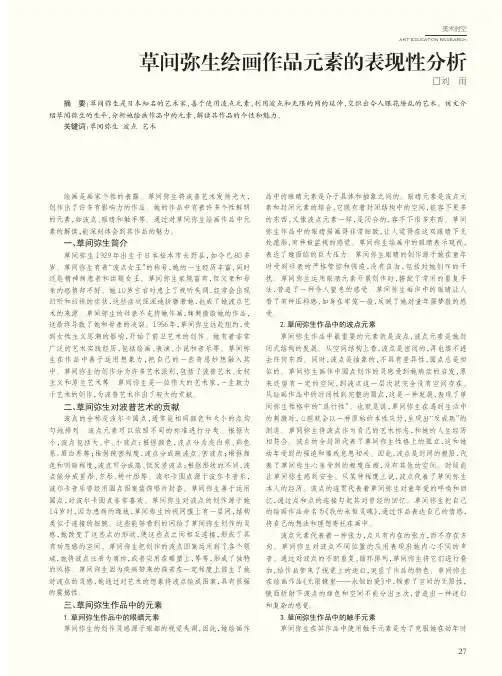
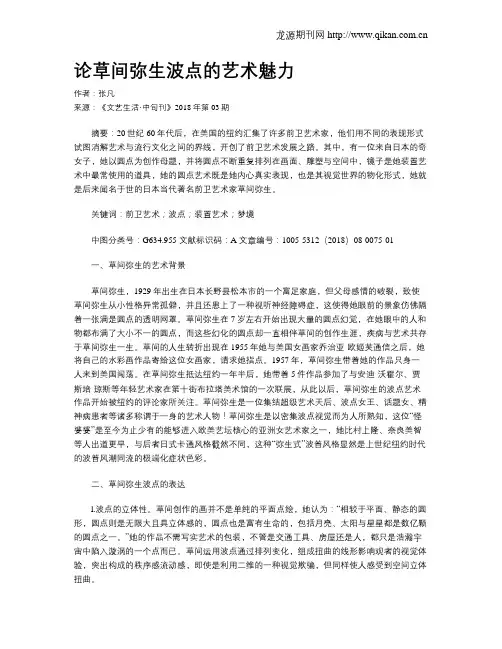
论草间弥生波点的艺术魅力作者:张凡来源:《文艺生活·中旬刊》2018年第03期摘要:20世纪60年代后,在美国的纽约汇集了许多前卫艺术家,他们用不同的表现形式试图消解艺术与流行文化之间的界线,开创了前卫艺术发展之路。
其中,有一位来自日本的奇女子,她以圆点为创作母题,并将圆点不断重复排列在画面、雕塑与空间中,镜子是她装置艺术中最常使用的道具,她的圆点艺术既是她内心真实表现,也是其视觉世界的物化形式,她就是后来闻名于世的日本当代著名前卫艺术家草间弥生。
关键词:前卫艺术;波点;装置艺术;梦境中图分类号:G634.955 文献标识码:A 文章编号:1005-5312(2018)08-0075-01一、草间弥生的艺术背景草间弥生,1929年出生在日本长野县松本市的一个富足家庭,但父母感情的破裂,致使草间弥生从小性格异常孤僻,并且还患上了一种视听神经障碍症,这使得她眼前的景象仿佛隔着一张满是圆点的透明网罩。
草间弥生在7岁左右开始出现大量的圆点幻觉,在她眼中的人和物都布满了大小不一的圆点,而这些幻化的圆点却一直相伴草间的创作生涯,疾病与艺术共存于草间弥生一生。
草间的人生转折出现在1955年她与美国女画家乔治亚·欧姬芙通信之后,她将自己的水彩画作品寄给这位女画家,请求她指点。
1957年,草间弥生带着她的作品只身一人来到美国闯荡。
在草间弥生抵达纽约一年半后,她带着5件作品参加了与安迪·沃霍尔、贾斯培·琼斯等年轻艺术家在第十街布拉塔美术馆的一次联展,从此以后,草间弥生的波点艺术作品开始被纽约的评论家所关注。
草间弥生是一位集结超级艺术天后、波点女王、话题女、精神病患者等诸多称谓于一身的艺术人物!草间弥生是以密集波点视觉而为人所熟知,这位“怪婆婆”是至今为止少有的能够进入欧美艺坛核心的亚洲女艺术家之一,她比村上隆、奈良美智等人出道更早,与后者日式卡通风格截然不同,这种“弥生式”波普风格显然是上世纪纽约时代的波普风潮同流的极端化症状色彩。
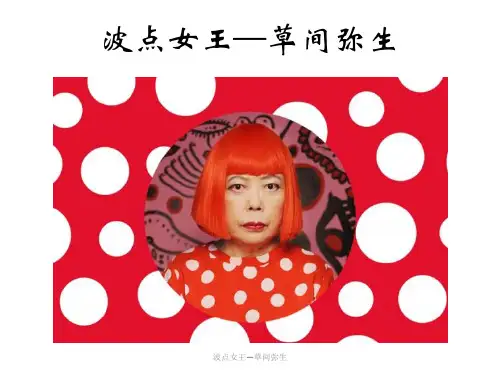
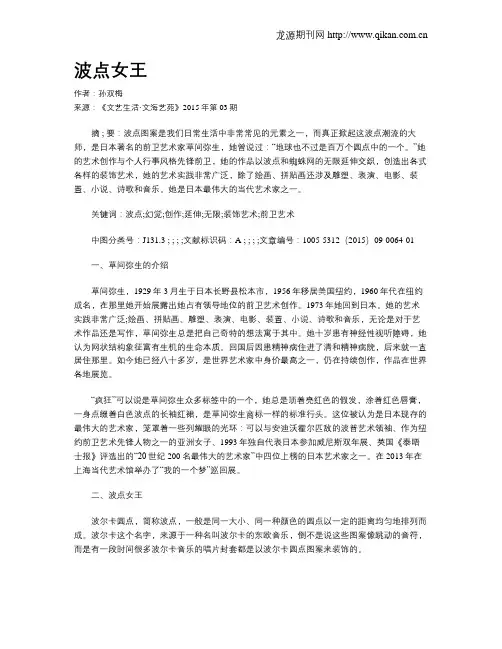
波点女王作者:孙双梅来源:《文艺生活·文海艺苑》2015年第03期摘 ; 要:波点图案是我们日常生活中非常常见的元素之一,而真正掀起这波点潮流的大师,是日本著名的前卫艺术家草间弥生,她曾说过:“地球也不过是百万个圆点中的一个。
”她的艺术创作与个人行事风格先锋前卫,她的作品以波点和蜘蛛网的无限延伸交织,创造出各式各样的装饰艺术,她的艺术实践非常广泛,除了绘画、拼贴画还涉及雕塑、表演、电影、装置、小说、诗歌和音乐。
她是日本最伟大的当代艺术家之一。
关键词:波点;幻觉;创作;延伸;无限;装饰艺术;前卫艺术中图分类号:J131.3 ; ; ; ;文献标识码:A ; ; ; ;文章编号:1005-5312(2015)09-0064-01一、草间弥生的介绍草间弥生,1929年3月生于日本长野县松本市,1956年移居美国纽约,1960年代在纽约成名,在那里她开始展露出她占有领导地位的前卫艺术创作。
1973年她回到日本。
她的艺术实践非常广泛;绘画、拼贴画、雕塑、表演、电影、装置、小说、诗歌和音乐,无论是对于艺术作品还是写作,草间弥生总是把自己奇特的想法寓于其中。
她十岁患有神经性视听障碍,她认为网状结构象征富有生机的生命本质。
回国后因患精神病住进了清和精神病院,后来就一直居住那里。
如今她已经八十多岁,是世界艺术家中身价最高之一,仍在持续创作,作品在世界各地展览。
“疯狂”可以说是草间弥生众多标签中的一个,她总是顶着亮红色的假发,涂着红色唇膏,一身点缀着白色波点的长袖红裙,是草间弥生商标一样的标准行头。
这位被认为是日本现存的最伟大的艺术家,笼罩着一些列耀眼的光环:可以与安迪沃霍尔匹敌的波普艺术领袖、作为纽约前卫艺术先锋人物之一的亚洲女子、1993年独自代表日本参加威尼斯双年展、英国《泰晤士报》评选出的“20世纪200名最伟大的艺术家”中四位上榜的日本艺术家之一。
在2013年在上海当代艺术馆举办了“我的一个梦”巡回展。
草间弥生教案及反思
教学目标:
1、认识草间弥生,欣赏她的波点系列作品,了解草间弥生的艺术表现特点。
2、掌握用波点系列的表现方法创作自己的花园。
教学过程:
一、导入
今天我们要来认识一位日本的当代艺术家一草间弥生,是一位酷爱九十岁的老奶奶了,她最喜欢用圆点点来进行艺术创作。
二、介绍草间弥生的创作背景
1、草间弥生为什么这么喜欢用圆点来画画呢?
2、引导学生了解草间弥生的生平
她几十年如一日的创作圆点和南瓜,这些作品也让她成为了日本有名的当代艺术家之一,她还被人们成为“南瓜女巫”和“波点女王”并且她还患有精神病所以她还被人们成为“怪婆婆”。
三、欣赏草间弥生的作品
1、作品中你看到了什么?
2、花朵上的圆点点都是一样的吗?
小朋友们欣赏完波点女王的故事,就请你们学习她的方式来创作一幅属于自己的梦幻花园吧。
反思
整个活动紧凑但不紧张,气氛热烈但不混乱,幼儿活动积极,乐
学、愿学,充分体现了以幼儿为活动主体、教师主导的纲要精神。
实现了通过对各种图形展开想象,充分发展幼儿的想象能力和动手能力以及培养幼儿的审美情感,增强对美术活动的兴趣的教育目标。